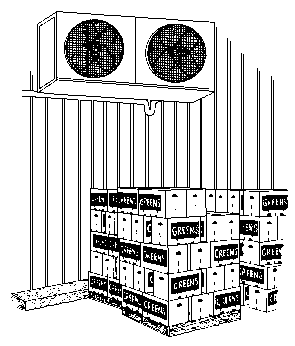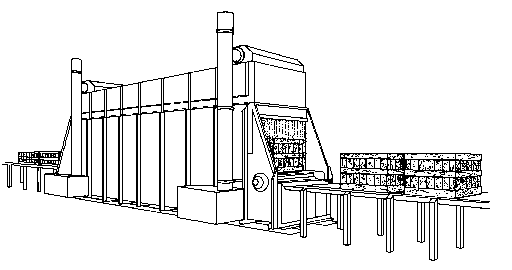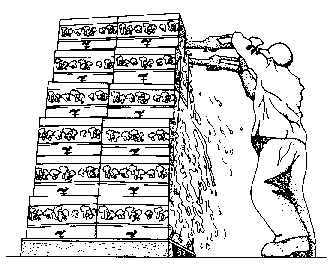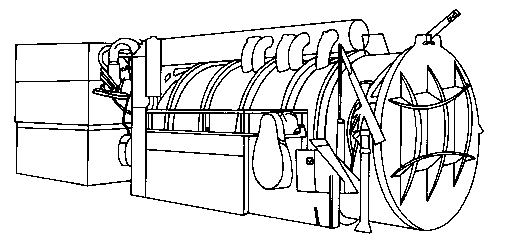Producing the consistently high-quality produce that spells success in a highly competitive market does not stop at the end of the row. The ability to deliver a quality product to the market and ultimately to the consumer commands buyer attention and gives the grower a competitive edge. Proper postharvest cooling and handling can help to ensure that quality is maintained until the product reaches the consumer.
Postharvest cooling rapidly removes field heat from freshly harvested commodities before shipment, storage, or processing and is essential for many perishable crops. Proper postharvest cooling can:
- Suppress enzymatic degradation and respiratory activity (softening)
- Slow or inhibit water loss (wilting)
- Slow or inhibit the growth of decay-producing microorganisms (molds and bacteria)
- Reduce production of ethylene (a ripening agent) or minimize the product's reaction to ethylene.
In addition to protecting quality, postharvest cooling provides marketing flexibility by making it possible to market at the optimum time. Being able to cool and store produce eliminates the need to market immediately after harvest, which can be an advantage for high-volume growers as well as pick-your-own (P-Y-O) operators who wish to supply restaurants and grocery stores. To select the best cooling method, it is necessary to understand the basic principles of cooling. The choice of cooling method depends on the following factors.
The nature of the product. Different types of produce have different cooling requirements. For example, strawberries and broccoli require near-freezing temperatures, whereas summer squash or tomatoes would be damaged by such low temperatures. Likewise, because of problems that can be caused by wetting of certain products, hydrocooling or icing may not be appropriate.
Product packaging requirements. The best choice of cooling method may depend on whether the produce is in a box, bin, or bag. The package design can have an effect on the method and rate of cooling.
Product flow capacity. Some methods of cooling are much faster than others. If the volume of produce to be cooled per season, per day, or per hour is large, it may be necessary to use a faster cooling method than would be used for lower volumes.
Economic constraints. Construction and operating costs vary among cooling methods. The expense of cooling must be justified by higher selling prices and other economic benefits. In some cases – for example, when the volume of produce is low – the more expensive methods cannot be made to pay for themselves.
Common Produce Cooling Methods
Room cooling is simply a matter of placing produce in an insulated room equipped with refrigeration units (Figure 1) to chill the air. It may be used with most commodities but may be too slow for some that require quick cooling. It is effective for storing precooled produce but in some cases cannot remove field heat rapidly enough. Carefully directing the output of the cooling system evaporator fans can significantly improve the cooling rate. Properly designed, a room cooling system can be relatively energy efficient.
A cooling room that is used only to store previously cooled produce requires a relatively small refrigeration unit. However, if it is used to cool the produce, a larger unit is needed. To determine the correct size of the refrigeration unit, consult a refrigeration contractor or Cooperative Extension. For more information, refer to Extension publication AG 414-2, Maintaining the Quality of North Carolina Fresh Produce: Design of Room Cooling Facilities.
Forced-air cooling is used in conjunction with a cooling room and can be used effectively on most packaged produce. To increase the cooling rate, additional fans (Figure 2) are used to pull cool air through the packages of produce. Although the cooling rate depends on the air temperature and the rate of airflow through the packages, this method is usually 75 to 90 percent faster than room cooling. When forced-air cooling fans are added to an existing cooling room, it may be necessary to increase the size of the refrigeration unit to accommodate the additional cooling load. The fans are normally equipped with a thermostat that automatically shuts them off as soon as the desired produce temperature is reached to reduce energy consumption and water loss from the produce.
Forced-air cooling can be very energy efficient and is an effective way to increase the heat removal rate of a cooling room. For more information refer to Extension publication AG 414-3, Maintaining the Quality of North Carolina Fresh Produce: Forced-Air Cooling.
Hydrocooling can be used on most commodities that are not sensitive to wetting. (Wetting often encourages the growth of microorganisms.) In this process, chilled water flows over the produce, rapidly removing heat. At typical flow rates and temperature differences, water removes heat about 15 times faster than air. However, hydrocooling is only about 20 to 40 percent energy efficient, as compared to 70 or 80 percent for room and forced-air cooling.
Hydrocoolers (Figure 3) were once rare in North Carolina but are becoming more common because they are able to cool a large amount of produce rapidly. For more information refer to Extension Publication AG 414-4, Maintaining the Quality of North Carolina Fresh Produce: Hydrocooling.
Top or liquid icing may be used on a variety of commodities. In the top icing process, crushed ice is added to the container over the top of the produce by hand or machine. For liquid icing, a slurry of water and ice is injected into produce packages through vents or handholds (Figure 4) without depalletizing the packages or removing their tops.
Icing is particularly effective on dense packages that cannot be cooled with forced air. Because the ice has a residual effect, this method works well with commodities that have a high respiration rate, such as sweet corn and broccoli. Icing is relatively energy efficient. One pound of ice will cool about 3 pounds of produce from 85 to 40°F. For more information refer to Extension publication AG 414-5, Maintaining the Quality of North Carolina Fresh Produce: Top and Liquid Ice Cooling.
Vacuum cooling is effective on products that have a high ratio of surface area to volume, such as leafy greens and lettuce, that would be very difficult to cool with forced air or hydrocooling. The produce is placed inside a large metal cylinder (Figure 5) and much of the air is evacuated. The vacuum causes water to evaporate rapidly from the surface of the produce, lowering its temperature. The process may cause wilting from water loss if overdone. Vacuum coolers can be energy efficient but are expensive to purchase and operate. They have only limited application to most common types of North Carolina produce.
Evaporative cooling is an effective and inexpensive means of providing a lower temperature atmosphere with high relative humidity for cooling produce. It is accomplished by misting or wetting the produce in the presence of a stream of dry air. Evaporative cooling works best when the relative humidity of the air is below 65 percent. At best, however, it reduces the temperature of the produce only 10 to 15°F and does not provide consistent and thorough cooling.
Produce should be picked during the coolest parts of the day and kept in the shade away from direct sunlight. In extremely hot weather, many growers in the western states have found that harvesting at night, "under the lights," is a good way to reduce the amount of mechanical cooling needed.
Table 1 summarizes postharvest cooling requirements for most of the commodities grown in North Carolina. Extension publications in series AG 413 provide postharvest cooling and handling recommendations for specific commodities.
| Commodity | Suitable Cooling Methods* | Optimum Temperature (°F) | Freezing Temperature (°F)** | Optimum Humidity (%) | Storage Life |
|---|---|---|---|---|---|
| Apples | R, F, H | 30-40 | 29 | 90-95 | 1-12 months |
| Asparagus | H, I | 36 | 31 | 95-100 | 2-3 weeks |
| Beans, snap | R, F, H | 40-45 | 31 | 95 | 7-10 days |
| Beans, butter | R, F, H | 37-41 | 31 | 95 | 5-7 days |
| Beets, topped | R | 32 | 30 | 98-100 | 4-6 months |
| Blueberries | R, F | 32 | 30 | 90-95 | 2 weeks |
| Brambles | R, F | 32 | 30 | 90-95 | 2 weeks |
| Broccoli | I | 32 | 31 | 95-100 | 2 weeks |
| Cabbage | R, F | 32 | 30 | 98-100 | 1-6 months |
| Cantaloupes | H, I | 32-40 | 30 | 95 | 2 weeks |
| Cucumbers | F, H | 45-50 | 31 | 95 | 2 weeks |
| Eggplant | R, F | 46-54 | 31 | 90-95 | 1 week |
| Green onions | H, I | 32 | 30 | 95-100 | 3-4 weeks |
| Leafy greens | H, I | 32 | 30 | 95-100 | 1-2 weeks |
| Okra | R, F | 45-50 | 29 | 90-95 | 7-10 days |
| Peaches | F, H | 32 | 30 | 90-95 | 2-4 weeks |
| Peas | F, H | 32 | 31 | 95-98 | 1-2 weeks |
| Peas, field | F, H | 40-41 | 30 | 95 | 6-8 days |
| Peppers | R, F | 45-50 | 31 | 90-95 | 2-3 weeks |
| Potatoes | R, F | 38-40 | 31 | 90-95 | 5-8 months |
| Squash | R, F | 45-50 | 31 | 95 | 1-2 weeks |
| Strawberries | R, F | 32 | 31 | 90-95 | 5-7 days |
| Sweet corn | H, I | 32 | 31 | 95-98 | 5-8 days |
| Sweetpotatoes | R | 55 | 31 | 90 | 6-12 months |
| Tomatoes | R, F | 45-50 | 31 | 90-95 | 1 week |
| Turnips | R | 32 | 30 | 95 | 4-5 months |
| Watermelon | R | 50-60 | 31 | 90 | 2-3 weeks |
| * R – room cooling; F – forced-air cooling; H – hydrocooling; I – icing ↵ ** CAUTION: Certain commodities may sustain appreciable chill damage at temperatures 10-20°F above the freezing temperature. Source: USDA Handbook No. 66. ↵ |
|||||
Other Steps for Maintaining Quality
Refrigerated transportation vehicles are not designed to remove field heat from produce. At best they can only maintain the temperature at which the produce was loaded. Growers, shippers, and truckers can contribute to better produce temperatures and hence fewer losses during transport by following these guidelines:
- Precool trailers before loading them, especially in warm weather;
- Measure and record the product's temperature during loading;
- Keep the trailer and refrigeration unit in good repair;
- Load the produce in a way that will ensure maximum air circulation;
- Keep transit times to a minimum.
For more information on refrigerated transit, refer to Extension publication AG 414-6, Maintaining the Quality of North Carolina Fresh Produce: Guide for Shippers.
Sponsored by the Energy Division, North Carolina Department of Commerce, with petroleum violation escrow funds, in cooperation with North Carolina Cooperative Extension, North Carolina State University. Any opinions, findings, conclusions, or recommendations expressed herein are those of the authors and do not reflect the views of the Energy Division, North Carolina Department of Commerce.
Publication date: Dec. 1, 1989
AG-414-01
N.C. Cooperative Extension prohibits discrimination and harassment regardless of age, color, disability, family and marital status, gender identity, national origin, political beliefs, race, religion, sex (including pregnancy), sexual orientation and veteran status.





